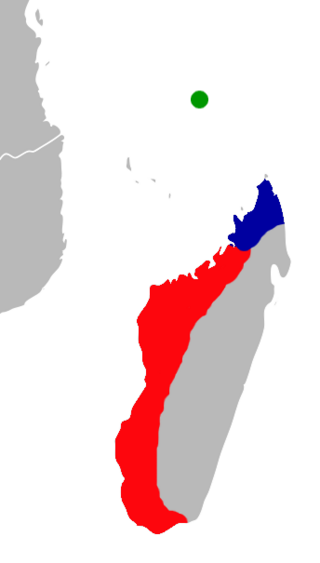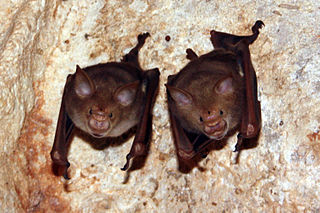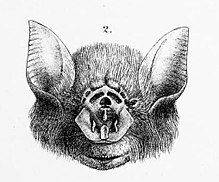
Horseshoe bats are bats in the family Rhinolophidae. In addition to the single living genus, Rhinolophus, which has about 106 species, the extinct genus Palaeonycteris has been recognized. Horseshoe bats are closely related to the Old World leaf-nosed bats, family Hipposideridae, which have sometimes been included in Rhinolophidae. The horseshoe bats are divided into six subgenera and many species groups. The most recent common ancestor of all horseshoe bats lived 34–40 million years ago, though it is unclear where the geographic roots of the family are, and attempts to determine its biogeography have been indecisive. Their taxonomy is complex, as genetic evidence shows the likely existence of many cryptic species, as well as species recognized as distinct that may have little genetic divergence from previously recognized taxa. They are found in the Old World, mostly in tropical or subtropical areas, including Africa, Asia, Europe, and Oceania.

The rufous trident bat, Persian trident bat, or triple nose-leaf bat is a species of bat in the genus Triaenops. It occurs in southwestern Pakistan, southern Iran, the United Arab Emirates, Oman, and Yemen. In the last country, it occurs together with the much smaller Triaenops parvus. Populations from Madagascar and mainland Africa have also been assigned to T. persicus, but are referable to the species Triaenops menamena and Triaenops afer, respectively. Madagascar populations have also been referred to as Triaenops rufus, but this name is a synonym of T. persicus.

The orange leaf-nosed bat is a bat in the family Rhinonycteridae. It is the only living species in the genus Rhinonicteris which is endemic to Australia, occurring in the far north and north-west of the continent. They roost in caves, eat moths, and are sensitive to human intrusion.

Rhinonicteris is a genus of leaf-nosed microbats, represented by fossil taxa found at Riverleigh in Queensland and the extant species Rhinonicteris aurantia, which occurs in the north and west of the Australian continent.

Grandidier's trident bat is a species of bat in the family Hipposideridae endemic to Madagascar. It was formerly assigned to the genus Triaenops, but is now placed in the separate genus Paratriaenops.

Triaenops is a genus of bat in the family Rhinonycteridae. It is classified in the tribe Triaenopini, along with the closely related genus Paratriaenops and perhaps the poorly known Cloeotis. The species of Paratriaenops, which occur on Madagascar and the Seychelles, were placed in Triaenops until 2009. Triaenops currently contains the following species:

Paratriaenops furcula, also known as Trouessart's trident bat, is a species of bat in the family Hipposideridae. It is endemic to Madagascar. It was formerly assigned to the genus Triaenops, but is now placed in the separate genus Paratriaenops. A related species, Paratriaenops pauliani, occurs in the Seychelles.

The Hipposideridae are a family of bats commonly known as the Old World leaf-nosed bats. While it has often been seen as a subfamily, Hipposiderinae, of the family Rhinolophidae, it is now more generally classified as its own family. Nevertheless, it is most closely related to Rhinolophidae within the suborder Yinpterochiroptera.
Brachipposideros is an extinct genus of leaf-nosed bats known from Riversleigh, north-western Queensland, Australia and the Languedoc-Roussillon Region, France. The fossils date to the late Oligocene to early Miocene.

Nyctophilus is a genus of the vespertilionids or vesper bats. They are often termed Australian big-eared bats or long-eared bats, as the length of their ears often greatly exceeds that of the head. This genus occurs in the New Guinean-Australian region.

Triaenops goodmani is an extinct bat from Madagascar in the genus Triaenops. It is known from three lower jaws collected in a cave at Anjohibe in 1996, and described as a new species in 2007. The material is at most 10,000 years old. A bat humerus from the same site could not be identified as either T. goodmani or the living T. menamena. T. goodmani is identifiable as a member of Triaenops or the related genus Paratriaenops by a number of features of the teeth, such as the single-cusped, canine-like fourth premolar and the presence of a gap between the entoconid and hypoconulid cusps on the first two molars. T. goodmani is larger than the living species of Triaenops and Paratriaenops on Madagascar, and on the first molar the protoconid cusp is only slightly higher than the hypoconid, not much higher as in the other species.

Triaenops menamena is a bat in the genus Triaenops found on Madagascar, mainly in the drier regions. It was known as Triaenops rufus until 2009, when it was discovered that that name had been incorrectly applied to the species. Triaenops rufus is a synonym of Triaenops persicus, a Middle Eastern species closely related to T. menamena— the Malagasy species had previously been placed as a subspecies of T. persicus by some authors. Triaenops menamena is mostly found in forests, but also occurs in other habitats. It often roosts in large colonies and eats insects such as butterflies and moths. Because of its wide range, common occurrence, and tolerance of habitat degradation, it is not considered to be threatened.

Paratriaenops is a genus in the bat family Hipposideridae. It is classified in the tribe Triaenopini, along with the closely related genus Triaenops and perhaps the poorly known Cloeotis. The species of Paratriaenops were placed in Triaenops until 2009. Paratriaenops currently contains the following species:

Paratriaenops pauliani is a species of bat in the family Hipposideridae. It is endemic to Aldabra Atoll of the western Seychelles, where it was found on Picard Island. It was formerly considered to be part of the species Triaenops furculus, known from Madagascar, and was initially assigned as a new species within the genus Triaenops. Later it as well as T. furculus were placed in the separate genus Paratriaenops. A related species, Paratriaenops auritus, also of Madagascar, was similarly reassigned.

The African trident bat is a species of bat found in Africa.
The Yemeni trident leaf-nosed bat is a species of bat found in the Middle East.
Brachipposideros nooraleebus is an extinct species of bat, known from a large series of fossil specimens found at Riversleigh fossil site in Australia. The nearest living relative is the orange horseshoe bat, Rhinonicteris aurantia, which occurs in the same area.
Rhinonicteris tedfordi is an extinct species of microbat, of the order Chiroptera, known from fossil material found in Australia.
Brevipalatus mcculloughi is a species of bat that existed in the early Miocene. It was discovered at a fossil deposit of the Riversleigh World Heritage Area.
Xenorhinos halli is a species of bat that existed in the early Miocene. It was discovered at a fossil deposit of the Riversleigh World Heritage Area in the north of Australia.









